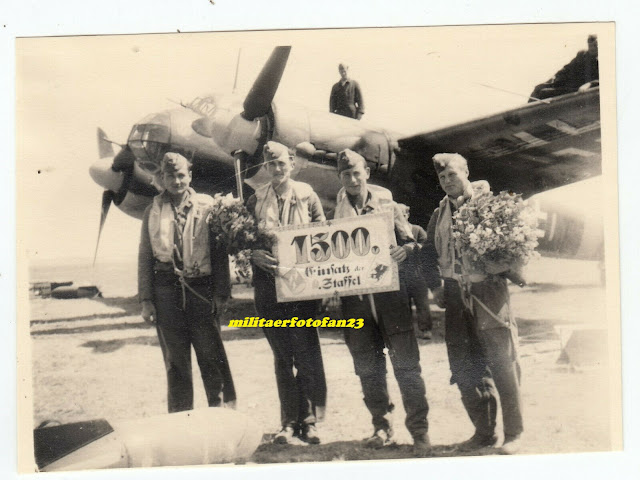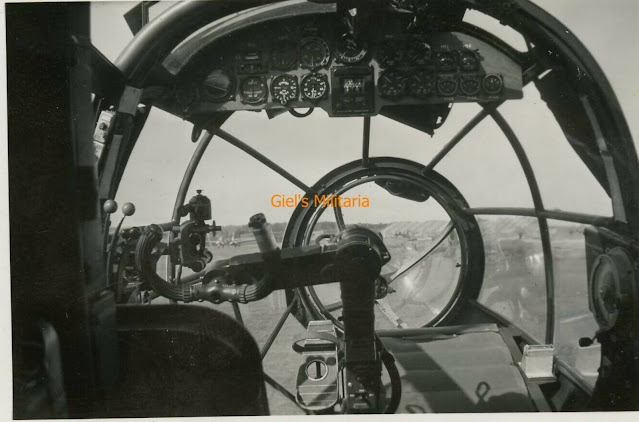During May 1942, as he was approaching 100 victories, Helmut Ostermann flew - and crashed - two different Friedrichs in quick succession, one on 10 May and the other on 12 May 1942 - this is a matter of record. The two different aircraft were crash landed within two days of each other, one after the other. Only one of these machines appears to feature in photographs and it has been generally thought up to now that it had differently finished fuselage sides - the starboard side was apparently left in the original paint scheme – the exact colours of which are a matter of conjecture but most probably 74/75 – whereas the port side of the fuselage was completely sprayed over in what is usually said to be a light gray, resulting in a marked difference of the appearance of the two sides of this a/c. I spoke to John MacIllmurray at AIMS who has an interesting theory about Ostermann’s machine(s) and who is currently preparing a new JG 54 decal sheet for release early in the New Year which will feature markings for Ostermann's Friedrichs.
"...The first Friedrich (W Nr. 13088 in 'standard' gray-greens) crashed on 10 May 42 ripping off the tail aft of the III. Gruppe symbol. The second machine - lost on 12 May two days later - was W.Nr 13125. Here the crash-landing also tore off the tail - on this occasion though in the middle of the III Gruppe bar! The photo report that appeared in Luftwaffe in Focus (5/2004 edition) actually mixes up photos from the two crash-landings! What was striking about the 'second' aircraft was the 76 overspray on the fuselage sides. Yes, RLM 76 sprayed over the fuselage sides and, yes, the photographs show two aircraft which look similar but they are not the same at all. Not surprisingly modellers and model companies are confusing them. What was the reason behind the 76 overspray? Well, most people imagine that this colour is a faint white or gray overspray - but what would be the point of that in mid-May? It is clearly much darker than the white of the fuselage
Balkenkreuz or the white outline of the numeral. My theory is that this may have been an attempt for concealment. Obviously high-altitude combat as such didn't occur in the East, but in painting over the fuselage sides in 76, Ostermann may have been looking for altitude concealment from low-flying Sturmoviks or even ground personnel/troops when flying his long-range strafing sorties behind the lines.."
See the Luftwaffe Gallery JG 54 'Special' for an account of these types of long-range strafing sorties flown by Ostermann. In the event the 'blue' machine, WNr. 13125, was only flown by Ostermann for two days before it crashed on 12 May 1942...
to reprise the differences on the two machines as seen in the various ‘crash’ photos that have been published;
Ostermann's 'gray-green' F-4 (W Nr. 13088) - 'wet' crash location, no straw under nose, no mud on top most prop lower area, different angle of half and half RLM 70 / white painted spinner, different damage to spinner tip, different painting of rear section of spinner, different damage to rear fuselage - ripped off aft of III Gruppe symbol - lower engine cowl ripped off in the crash. See clearly right side photo and small photo of left side!
Ostermann's 'blue' machine (W.Nr 13125)
High up demarcation 74/76 machine, 'dry' crash location, straw under nose, mud on upper prop, angle of white/RLM 70 spinner different, painting of spinner different, tail ripped off near beginning of III Gruppe symbol and the lower engine cowling intact and in situ. Note too the 8th Staffel bird may well be also in a different place on the two aircraft - 13088 has it near the front of the cowl, 13125 it is in the centre as per normal.
Bf 109 F-4 – WerkNr. 13 088 – was covered in detail in JFV 9/III, JG 54 Luftwaffe Gallery and various editions of Luftwaffe im Focus and pictures published thus far are usually thought to show an aircraft with differently finished fuselage sides. This highly unusual scheme could be seen on a number of 8./JG 54 Bf 109 F-4s in the spring of 1942, apparently being some kind of intermediate scheme during the spring thaw. (III./JG 54 was only some 50 km south of Leningrad)
But, as is evident from John's comments, it may well be that we have actually been looking at two different aircraft, one of which was 13 088, the other 13 125....over to John again;
"..Regardless of the similarities between 13088 crashed on the 10th and 13125 crashed on 12 May the fact remains that the crash photos from the left show 13125 and the photos from the right show 13088. The photos show two aircraft with two different tail rips, two different spinners and one with lower cowl ripped off and one without - two different crashes - two different aircraft - two different locations - regardless of similarities. It is perhaps a little odd that 13088's 74/75 fuselage is only ever seen from the right and bizarre in the extreme that 13125 in the 'high up' RLM 76 is only ever seen from the left but that is what we have been left with!
Since the crash photos show one side only of both aircraft it cannot be proven that work was started to paint the left side of 13088 RLM 76 nor can it be proven that 13125 had the RLM 76 finished on the right for that matter but the head-on photo of it on a dry sunny day (LiF 5/2004) would suggest that it is more finished than un-finished...."
Preview image of just some of the subjects on the forthcoming AIMS JG 54 decal sheet
A final word from John at AIMS;
".. if I'm wrong about this then that's cool too - I am happy to be wrong and thankfully it does not in any way change the decal designs - just the instructions. Okay so the identical paint scheme on the tail plane and wings of both aircraft could be a 'problem for sure but less of a problem - in my mind - than believing all the crash photos are the same aircraft. It would not be the first time an aircraft crashed in an unfinished condition but rare none the less..."
AIMS is also almost ready to start taking orders on a new Bf 110 conversion set - a Bf 110 G-2/R1 conversion for the 32nd Dragon C-7 kit. There are also new 1/72 and 1/48 update sets for the Eduard G-2/R-1 or G-2 kits in the pipeline ..
The Bf 110 G-2/R1 sub-type was a Pulkzerstörer for defence of the Reich duties mounting the imposing 3.7cm Bordkanone Flak 18 under the fuselage. After trials this variant first equipped ZG 76 in late 1943/early 1944. Some of these machines were also equipped with WGr. 21 rocket launchers under each wing. Below, decal sheet extract depicting ZG 76 machines
"M8+NP" a Bf 110 G-2/R1 seen in Wertheim in late 1943. FF Uffz. Herbert Stengel on the right. Note the lower fuselage fairing/housing for the cannon rather resembled the 'Dackelbauch' fitting seen on the Bf 110 D. The cannon muzzle brake was perforated.
More photos and data on the Bf 110 G-2/R1 Flak 18 on this blog
here






































